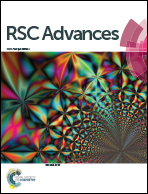Improvement of performance of a Au–Cu/AC catalyst using thiol for acetylene hydrochlorination reaction†
Abstract
In order to overcome problems of Au–Cu bimetallic catalysts for acetylene hydrochlorination reaction such as instability, Au–Cu–SH/AC catalysts were prepared through the introduction of thiol and tested to examine their activity and stability. It was found that performances of Au–Cu–SH/AC catalysts were quite excellent, with significantly higher catalytic activity and better stability than performances of Au/AC and Au–Cu/AC catalysts. The contents of Cu and thiol additives were also optimized and the optimum molar ratio of Au/Cu/SH was 1 : 1 : 10. Catalyst samples were characterized by scanning electron microscopy (SEM), nitrogen adsorption/desorption (BET), X-ray diffraction (XRD), transmission electronic microscopy (TEM), H2 temperature-programmed reduction (H2-TPR), and X-ray photoelectron spectroscopy (XPS). It was demonstrated that the Au–Cu–SH/AC catalysts were Au0-based catalysts, due to thiol reducing Au3+ to Au0 species during the preparation process. Au0 species exhibited better catalytic activity than Au3+ species for acetylene hydrochlorination, according to the comparison with the composition of active species in different samples through XPS. Furthermore, the sulfhydryl of thiol could bond to the surface of gold nanoparticles (Au NPs). It helped in mitigating the oxidation of Au0 by HCl, protecting Au NPs from structure damage, stabilizing Au NPs in a nearly constant particle size and keeping a more active structure in the reaction environment. Thus, improved dispersity of active species and protection of the active structure of the Au NPs resulted in the better catalytic activity and stability of Au–Cu–SH/AC.


 Please wait while we load your content...
Please wait while we load your content...